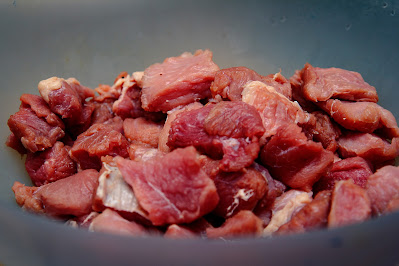The topic of raw feeding for dogs is highly debated among pet owners, veterinarians, and experts. While some people advocate for the benefits of raw feeding, others have concerns about potential risks. It's important to consider both perspectives.
Benefits of Raw Feeding According to Advocates
Advocates of raw feeding for dogs believe this diet offers several potential benefits. They argue that it can improve the following:
Dental Health
Chewing on raw bones can help promote dental health by reducing tartar and plaque buildup and strengthening the jaw muscles.Improved Coat and Skin
Raw feeding enthusiasts often report that their dogs' coats become shinier and skin conditions improve.Enhanced Digestive Health
A raw diet more closely resembles what dogs' ancestors would have eaten in the wild, and it may lead to better digestion and fewer digestive issues.Increased Energy and Stamina
Supporters argue that raw diets can provide dogs with a natural energy source and improve their overall vitality.Raw Feeding Concerns According to Critics and Skeptics
On the other hand, critics and skeptics raise various concerns about raw feeding for dogs. They worry about the following:
Nutritional Imbalances
Crafting a nutritionally balanced raw diet for dogs requires careful consideration and knowledge. Providing the correct balance of essential nutrients, vitamins, and minerals can be challenging without professional guidance. An imbalanced diet can lead to deficiencies or excesses.Risk of Foodborne Illnesses
Raw meat can contain bacteria like Salmonella or E. coli, posing a health risk to dogs and humans. While dogs have a more robust digestive system than humans, they can still get sick from contaminated raw food.Potential Injuries
Consuming raw bones can carry risks, as they may splinter and cause choking, dental fractures, or gastrointestinal obstructions if not properly supervised.Zoonotic Concerns
Handling and preparing raw food for dogs increases the risk of zoonotic infections, where humans can contract diseases from animals.How do I Introduce Raw Food to My Dog?
Research and Consultation
Research raw feeding principles and understand the nutritional requirements for dogs.Consult a veterinarian who can guide you based on your dog's needs and health conditions.
Determine the Raw Food Plan
Decide on the type of raw food you plan to feed your dog, such as commercially prepared or homemade raw diets.Choose high-quality ingredients, including raw meat (muscle meat), bare meaty bones, and organ meats (liver, kidney, etc.).
Consider the appropriate balance of proteins, fats, and carbohydrates for your dog's age, size, and activity level.
Start with a Transition Period
Mix a small portion of raw food with your dog's regular food. Start with a ratio of about 10% raw food to 90% traditional food.Gradually increase the proportion of raw food over several weeks. For example, increase to 25% raw food in the second week, 50% in the third week, 75% in the fourth week, and finally 100% raw food in the fifth week.
Observe Digestive Response
Monitor your dog's digestive response throughout the transition period. Look for signs of digestive upset, such as diarrhea, vomiting, or discomfort.If digestive issues occur, slow the transition process and stick with the previous ratio until your dog's system adjusts. You can also consult your veterinarian for professional advice.
Variety and Balanced Nutrition
Aim to provide a variety of protein sources to ensure a balanced diet over time. Include different meats (chicken, beef, lamb, etc.) and organ meats (liver, kidney, etc.) to offer a wider range of nutrients.Consider mixing small amounts of fruits and vegetables, pureed or finely chopped, to provide additional fiber and micronutrients. Ensure these are safe for dogs, and avoid toxic foods like grapes, onions, or avocados.
Introduce Raw Meaty Bones
Introduce raw meaty bones appropriate for your dog's size and breed. These can serve as a natural teeth-cleaning mechanism and provide mental stimulation.Start with softer bones like chicken or turkey necks and gradually progress to larger, harder bones. Always supervise your dog during chewing sessions to prevent choking hazards.
Monitor Overall Health
Monitor your dog's health, energy levels, coat condition, and weight. Note any positive changes or potential concerns.Regularly visit your veterinarian for check-ups and discuss your dog's raw food diet to ensure good health.
Practice Hygiene
Maintain good hygiene throughout the process. Wash your hands properly after handling raw food.Clean and disinfect food bowls, utensils, and preparation surfaces with hot, soapy water to minimize the risk of bacterial contamination.
Every dog is unique, and the transition to raw food may vary. Pay attention to your dog's individual needs and make adjustments accordingly.
If you have any concerns or questions, consult a veterinarian to ensure a successful and balanced raw food diet for your dog.
What Age Can Dog Eat Raw Food?
Puppies can typically start eating raw food around 8 to 12 weeks, depending on their development and their veterinarian's advice. The exact age at which a dog can safely transition to a raw food diet may differ based on breed, size, overall health, and the puppy's specific needs.
Puppies require specific nutritional requirements for growth and development. When introducing raw food to puppies, ensuring the diet is balanced and meets their dietary needs is crucial.
Can I Feed My Dog Raw Meat Sawdust?
It does not provide a balanced and nutritionally complete diet that dogs require. Feeding your dog a diet specifically formulated for their nutritional needs is important, using high-quality ingredients and appropriate preparation methods.
Conclusion
Ultimately, each dog is unique, and what works for one may not work for another. It is crucial to prioritize the health and well-being of your dog by seeking expert guidance, monitoring its response to the diet, and making adjustments as necessary.
The ultimate goal is to provide a balanced, nutritious, and safe diet that supports your dog's overall health and longevity.




















0 comments:
Post a Comment